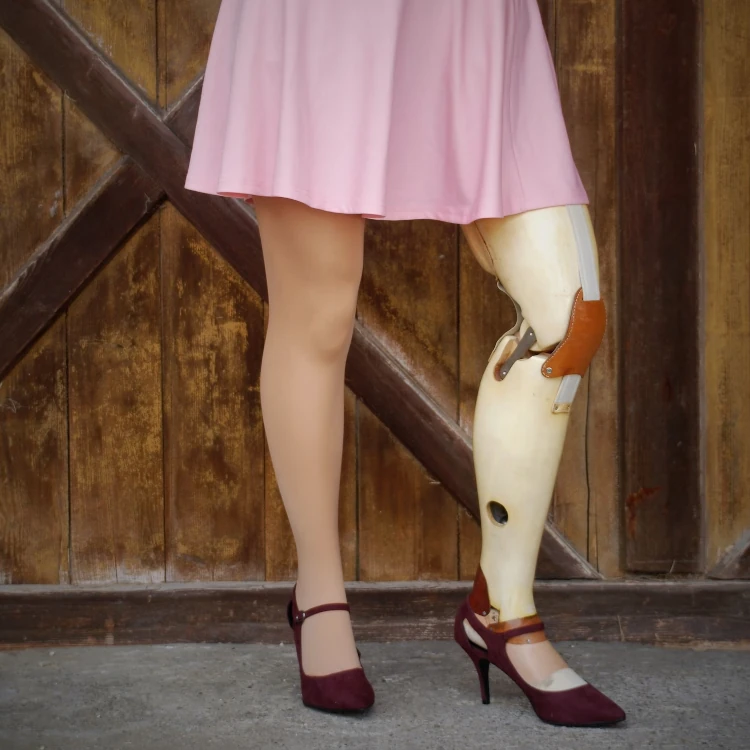
It can be jarring to come across an image of a Nokia cellphone from, say, 1995—fat and oblong like a hoagie roll, with a full array of push-button digits and an actual antenna sticking out the top. No camera, no touchscreen, no wifi connection; no function at all beyond remote voice communication, the same solution Alexander Graham Bell produced a century earlier. It’s almost hard to believe these primitive devices existed in our own lifetimes, or that we considered them dazzlingly futuristic when they first appeared.
We get the same feeling while browsing through Stephan Boos’s emporium of old prosthetic devices on Etsy. We came across the shop when we were putting together last week’s gift-giving directory, and we decided not to list it there for a few reasons. Primarily, we held it back because the exotic merchandise isn’t for everyone. But for the right person, it’s an awesome selection—dozens of gorgeous old prosthetic limbs that seem to come from the Stone Age but are actually of roughly the same vintage as that Nokia phone.
These distinctive devices are incredibly cool. There’s a certain kitschiness to their appeal, but Boos—a former prosthetist from Munich—has a serious purpose in collecting and preserving them.
“My wife (Natalia) is an above-knee amputee herself for more than 20 years,” he emailed us yesterday, “and we both try to turn a ‘needed medical device’ into something special. We don’t like ‘abled’ people looking at disabled people with pity. We want to show the ‘sunny side up’ of being different. We know a lot of people who try to see it the same way, so we started to sell prosthetics for photo shoots, fashion shows, or just for everyday life (but not the technical part). We both also are fascinated by the craftsmanship of earlier decades and try to preserve these artifacts from earlier days.”
These old limbs also represent the deep roots of the current trend toward imaginative designs that turn prosthetic limbs into vehicles for self-expression. “In almost all parts of life, ‘healthy people’ are free to decide about ANYTHING connected with their accessories, clothes and even body,” Boos wrote. “They are free to choose sports, hobbies, decide about face shape, breast size, and so on and so on. But if an amputee went to a prosthetist a couple of years ago and told them, ‘I would like my leg looking like a steampunk accessory,’ they only heard ‘It’s not possible’ or even ‘It’s not allowed’ or ‘There is no sense in doing that.’ Why do ‘disabled’ people get patronized all the time? Why do they need to explain the sense of something they want to have, if others don’t need to? Why can ‘healthy’ people wear dangerous high heels but amputees can’t?”
“At least stylish leg covers and colorful sockets are getting common,” he wrote in closing. “But it’s still a long way to go to real EQUALITY!”
Check out the store at this link. These are one-of-a-kind finds, so the inventory is constantly changing. Everything is on sale (10 percent off) through December 17. Below are a few of our favorites that are currently in stock (click on any picture for item details).
It’s not every amputee who can pull off the red-stiletto-plus-lion’s-paw look. This device was custom designed for a German model who lost her right leg in the late 1990s and worn during a fashion event / photoshoot. The prosthesis features a hydraulic knee joint and is still in working order. Discount price is $314.10.
Think of this as the Hero Arm of thirty years ago. Although it’s no longer in working order, this below-elbow device boasted myoelectric function in its day. The socket’s made of resin, the hand is metal, and there’s also some leather componentry in there. Discount price is $179.10.
Sold as a pair, this above-knee/below-knee combo originally belonged to a woman who lost both legs in a car accident. The right leg includes a hydraulic joint, while the left features leather and metal thigh straps. These are nonfunctioning legs, manufactured in Germany in the late 1990s / early 2000s. Discount price is $269.10.
If you lost a leg in the 1980s and wanted to wear high heels with your prosthesis, good luck. The owner of this device says: “If you asked me [back then] what bothered me most about being an amputee, I would have answered not being able to wear short dresses and heels!” This circa-1985 leg includes a flexing ankle that can accommodate heels of up to 6 cm. Discount price is $242.10.
Boos’s current inventory tilts heavily toward women’s devices, but here’s one for the fellas. This all-wooden leg with a mechanical knee dates to roughly 1994, but it might as well have been built in 1954. Despite many years of use, it remains fully functional. Discount price is $206.10.









